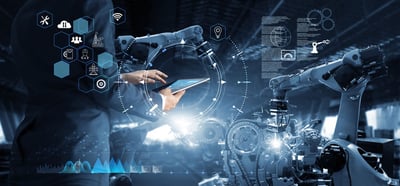3 exciting innovations in logistics
With emerging technologies, changing environmental regulations, and increased automation across all sectors, innovation is exploding in the logistics industry.
From hypersonic cargo transport to autonomous robots to alternative fuels, here are three innovations to look out for.
Hyperloop
Key advantages:
- increased speed
- lower cost
- sustainable
 Hyperloop is a still-theoretical transportation system—first proposed by Elon Musk in 2012—which propels cargo-filled pods at high speeds through steel tubes.
Hyperloop is a still-theoretical transportation system—first proposed by Elon Musk in 2012—which propels cargo-filled pods at high speeds through steel tubes.
Cargo pods travel through the sealed tube or system of tubes with low air pressure, moving substantially free of air resistance or friction.
- Could move people or cargo at airline or hypersonic speeds
- Very energy efficient
- Would drastically reduce transport times
- Could be cheaper and better for the environment than planes and trains
Alternate fuels for marine shipping
Key advantage:
- reduced greenhouse gas emissions
Marine fuels are a hot topic with the IMO’s assertive goal to reduce emissions. While low-sulphur fuels are the most popular in the industry at this time, there are several alternative fuels that may reduce greenhouse gas (GHG) emissions even more.
Liquefied natural gas (LNG)
- Produces almost no sulfur oxide or particulate matter emissions. Low nitrogen oxide emissions and GHG emissions between 7 and 22% depending on engine type
- LNG in combination with a combined cycle diesel/carbonate fuel cell could reduce CO2 emissions by up to 80%
- Ships won’t achieve zero CO2 emissions with LNG alone
Liquefied petroleum gas (LPG)
- Limits carbon output, but doesn’t eliminate CO2 emissions
- LPG terminals are operational worldwide, but bunkering infrastructure is lacking
- Production of LPG is currently insufficient , but it will be part of the larger solution
Methanol and ethanol
- Similar profile to LPG
- Well-developed global terminal network, but bunkering facilities are limited
- Due to the toxic and flammable nature, methanol- and ethanol-fueled ships need to be designed and operated with specific care
Biofuels and synthetic methane (SNG)
- Biofuels are carbon-neutral solution, but mass-scale production is not yet sustainable
- Synthetic methane/substitute natural gas (SNG) and bio-methane are are compatible with current LNG propulsion technologies
- Can theoretically be carbon-neutral alternatives when used with carbon capture and fuel cell technology.
Hydrogen and ammonia
- Intrinsically carbon free, these fuels produce zero CO2 emissions when sourced renewably. Both are clean fuel solutions for internal combustion engines and fuel cells
- Both fuels have a much lower energy density than traditional fuel oils—needs to be accounted for in ship design and will impact costs
Warehouse Robotics
Key advantages:
- improved service
- lower costs
 Using robotics in the warehouse can improve service and lower costs with a “worker” that can operate 24/7.
Using robotics in the warehouse can improve service and lower costs with a “worker” that can operate 24/7.
- Boston Dynamics’ has developed an autonomous warehouse robot which unloads trucks, builds pallets, and moves boxes throughout any warehouse facility
- Robotization can significantly improve the efficiency and speed of warehouse processes
- More warehousing companies are including autonomous robots every year
While many of these innovations are years ahead of our industry, and implementation often happens slowly, we are starting to see logistics solutions blending sustainability with efficiency and cost savings.
As the future of logistics unfolds, contact your logistics partner today to learn more about streamlining your operations in the present.
Information provided by: Freight Dept - Cole International
Innovation in logistics. It's what we do.

Latest Articles
- Watch out for these extra charges on your freight bill
- Key differences between duty drawbacks and duty refunds for importers
- Mitigating container shortages and rising shipping prices for ocean imports
- How Canadian importers benefit from end use tariff codes and conditional relief
- The benefits of operating as a Non-Resident Importer in Canada
